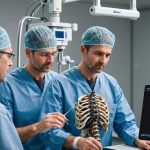Overview of Minimally Invasive Spine Surgery
Minimally Invasive Spine Surgery is a surgical technique aimed at reducing damage to muscle tissue and speeding up recovery time. Unlike traditional open surgery that requires large incisions, this method employs smaller cuts, specialised instruments, and sometimes, robotics. These innovations mean less pain and quicker return to daily activities.
Historically, spine surgery required significant incisions, leading to extended recovery periods. However, the evolution of techniques in recent decades, such as the use of endoscopes and advanced imaging, has revolutionised patient outcomes. Procedures have progressively become more precise, enhancing both efficacy and safety.
Have you seen this : Integrating Mindfulness Practices in Patient Care: A Guide for UK Mental Health Nurses
In modern medical practices, patient-centric care is of paramount importance. This approach involves tailoring treatment plans to individual needs, minimising risks, and focusing on holistic recovery strategies. Minimally invasive methods align seamlessly with these principles by prioritising effective treatment with the least disruption to the patient’s life.
The benefits of this surgical advancement include reduced postoperative pain, fewer complications, and a shorter hospital stay. Such advantages underscore the practical utility and growing demand for minimally invasive options in addressing spine-related issues.
Also to see : Empowering UK Midwives: Strategies to Assist Mothers Overcoming Breastfeeding Challenges
Advanced Techniques Employed by UK Orthopedic Surgeons
In the realm of orthopedic surgery, UK specialists have adopted significantly advanced techniques to enhance patient outcomes. These innovations not only improve surgical precision but also shorten recovery time.
Endoscopic Discectomy
Endoscopic discectomy is a minimally invasive procedure targeting spinal disc problems. Using a tiny incision, UK orthopedic surgeons insert an endoscope to remove or repair damaged discs. Compared to traditional surgery, this technique causes less tissue damage, leading to shorter hospitalization and faster rehabilitation.
Microsurgical Techniques
Microsurgical techniques involve the use of high-powered microscopes during surgery, enabling surgeons to handle extremely delicate structures with precision. This approach is particularly beneficial in complex procedures involving nerves and small blood vessels. Patients generally experience less pain and quicker recovery than with conventional methods.
Robotic-Assisted Surgery
Robotic-assisted surgery has revolutionised the precision of orthopedic procedures. Surgeons control robotic arms that can execute exact movements, minimising error and enhancing outcomes. Compared to traditional surgery, robotic-assistance offers substantial advantages, such as reduced risk of infection, less blood loss, and faster recovery. The combination of surgical innovations like these demonstrates a commitment to elevating healthcare standards through technology.
Case Studies and Success Rates
Examining case studies can provide valuable insights into the world of surgical procedures. They offer a wealth of information about real-world applications and outcomes. In recent years, there has been increasing documentation of successful surgeries, particularly those adopting minimally invasive techniques. These methods have demonstrated high success rates, often surpassing traditional surgical techniques, due to their precision and reduced recovery times.
Numerous studies have collated statistical data illustrating these success rates. For instance, the overall patient outcomes have significantly improved, with a noticeable drop in postoperative complications and shorter hospital stays. These techniques have proven to be advantageous, with each case study providing a unique illustration of its effectiveness.
Patient outcomes are documented thoroughly, often highlighting profiles with varying complexities. These profiles demonstrate the adaptability of minimally invasive approaches across a range of conditions. Despite differing patient backgrounds and conditions, the consistency in achieving positive results is notable. This body of evidence supports the growing preference for these innovative techniques.
The landscape of modern surgery is increasingly defined by these techniques, offering patients solutions that were previously deemed high-risk or inefficient, showcasing a promising outlook for future medical procedures.
Profiles of Leading UK Orthopedic Surgeons
The realm of orthopedic surgery in the United Kingdom is graced by several leading surgeons who are pioneering minimally invasive techniques. Their expertise in this advanced field not only enhances patient outcomes but also significantly reduces recovery times. By employing cutting-edge procedures, these surgeons contribute to transformative advancements in orthopedic care.
Many specialists focus on techniques that minimise surgical trauma. This approach has revolutionised treatment protocols and allowed for less post-operative discomfort and complications. In turn, patients benefit from quicker returns to daily activities. The leading surgeons apply their in-depth knowledge and experience to perform surgeries that were once considered too complex through minimal invasion.
By introducing novel procedures such as endoscopic spine surgery and advanced arthroscopy, these surgeons are at the forefront of orthopedic innovation. Their impact is evident in the improved quality of life of countless patients. Additionally, they serve as mentors, training the next generation of surgeons and continually refining surgical techniques to push the boundaries of what is possible. Through their work, the field continues to progress, offering new hope and enhanced care options for patients everywhere.
Patient Testimonials and Experiences
When considering minimally invasive spine surgery, real-life patient testimonials provide invaluable insights into the process and outcomes. Many patients have shared their experiences, highlighting significant improvements in their quality of life post-surgery. These testimonials often reflect on the efficiency of the procedure and the care received during their treatment journey.
Patients consistently report reduced pain and quicker recovery times compared to traditional surgery methods. Their firsthand experiences emphasise the importance of informed decision-making in choosing the right treatment option. Understanding patient care expectations and outcomes helps others make educated decisions regarding minimally invasive surgical options.
Furthermore, these accounts reveal a high degree of patient satisfaction, offering assurance to those contemplating similar procedures. Patients describe the adept handling of their cases by healthcare professionals as a key factor in their positive experiences.
Analysing these experiences underscores the importance of personalised treatment plans and comprehensive care, ensuring that patients are well-informed and supported throughout their recovery. This reinforces the value of aligning patient care with individual needs to enhance satisfaction and long-term benefits post-surgery.
Latest Research Findings in Minimally Invasive Techniques
In recent years, research findings have paved the way for remarkable innovations in minimally invasive techniques. This section examines the latest clinical trials and their implications for patient care.
Recent Clinical Trials
Recent clinical trials have explored a series of groundbreaking minimally invasive techniques, demonstrating promising results in terms of patient recovery times and overall effectiveness. These studies have examined everything from novel surgical tools to advanced imaging systems, illustrating a clear commitment to enhancing patient safety and outcomes.
Emerging Technologies
Innovations in this field have given rise to several emerging technologies that are poised to transform medical practices. This includes the development of robotic-assisted surgeries and refined endoscopic methods, both promising reduced complications and shorter hospital stays for patients.
Predicted Trends in the Field
Looking ahead, predicted trends suggest a shift towards more personalised treatment plans as precise research findings continue to align with technological advancements. Future directions entail leveraging data analytics to refine surgical procedures further, ensuring they become even less invasive. Such advancements offer great potential to redefine patient care standards globally, making complex surgeries more accessible and efficient.
Potential Risks and Benefits of Minimally Invasive Spine Surgery
Minimally invasive spine surgery is becoming increasingly popular due to its associated benefits and potential for enhancing patient safety. However, like all surgical procedures, it is essential to understand the potential risks. Common risks include infection, nerve damage, and blood loss, albeit at reduced rates compared to traditional surgery. Patients may also experience numbness or temporary discomfort post-surgery.
The upside of minimally invasive techniques lies in their distinct benefits over conventional methods. These techniques typically result in shorter recovery times, reduced pain, and a lower chance of complications. Furthermore, because the incisions are smaller, patients benefit from minimal scarring and quicker return to daily activities.
For those contemplating surgery, assessing the surgery implications is crucial. It is recommended to thoroughly discuss with a healthcare provider to evaluate all available options, balancing risks and rewards. An informed decision can enhance patient outcomes and satisfaction, ensuring the selected surgical method aligns with individual needs and health conditions.
Patient safety remains a priority, and understanding these facets helps patients make educated decisions about their healthcare.











